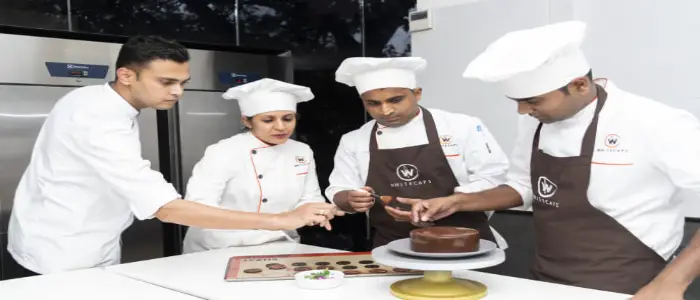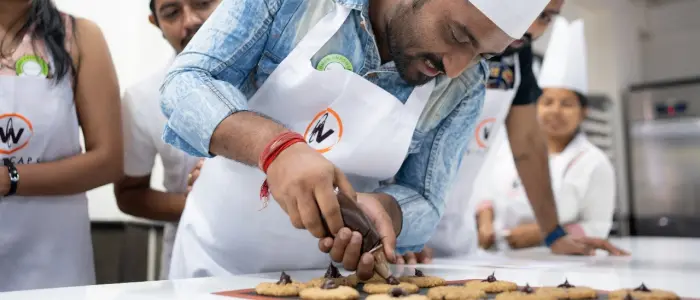In baking, chocolate is a key ingredient and may or may not complement your recipe, depending on the chocolate you use. The texture, flavour and the percentage of cocoa that you use count a lot in the result of your brownies, cakes or cookies. However, there are too many choices in the market, the dark, the milk, and the couverture, that it can be quite difficult to determine which one matches your dessert.
In this tutorial, we will deconstruct each of these types of baking chocolate, contrast the features of each type, and provide some tips from high-level professional chefs of Whitecaps International, the leading baking academy in India. This will assist you in choosing chocolate for baking, whether you are a beginner or an aspiring chocolatier.
What Is Baking Chocolate?
Cooking chocolate, also known as baking chocolate, is a chocolate specially made to be used in desserts. In comparison to ordinary consuming chocolate, it is made to melt completely, blend seamlessly, and maintain flavour in high temperatures.
Baking chocolate is unique in two ways:
- Increased cocoa content: It is richer in flavour and texture.
- Fewer additives and sugar: It provides bakers with complete control over sweetness and consistency.
Simply put, baking chocolate is your canvas, you determine how aggressive, creamy, or shiny your final product will be. And if you’re eager to master the art of working with chocolate, explore professional pastry and baking courses designed to help you perfect every technique.
3 Main Types of Baking Chocolate
Chocolate baking is not a one-size-fits-all. Both types add a personality to your meals, whether the dark chocolate is rich and intense, or the milk chocolate is creamy and smooth, or the glossy perfection of couverture.
Examining the difference between these varieties will enable you to balance flavour, texture and appearance of your desserts. We are going to discuss the most common forms of high quality baking chocolate and how each can be utilised to its utmost potential.
What Is Dark Chocolate?
The dark chocolate is the one with a high percentage of cocoa, usually 60-85 percent and a very small amount of milk in it. Its bitter-sweet taste is very intense and is the favourite of professional bakers.
It works well with brownies, cookies, and ganache, where richness and depth are the most important aspects. The dark chocolate for baking has a more stable structure and can be used in melting or tempering because it can maintain its structure in baking. You can check out some surprising nutritional perks and rich composition of dark chocolate to learn more about why it’s so popular among chocolate lovers.
Pro Tip: Dark chocolate should be of good quality, containing cocoa butter (not vegetable oil) to provide the best finish and best flavour. India Brand Equity Foundation (IBEF) reports that the sales of chocolates in India have grown to over 1,500 million US dollars in 2017, compared to less than 100 million US dollars in 2000.
What Is Milk Chocolate?
Milk chocolate is smoother, sweeter, and has a cocoa content of 30%-50%. It is prepared using milk solids or condensed milk, which gives it a softer melt-in-mouth texture.
It is a delicious chocolate to use in light desserts, mousses, and frostings, where you desire a gentle touch of chocolate flavour, but not a sharp blast of bitterness.
Nevertheless, due to its increased sugar and milk content, milk chocolate for baking is easy to burn or seize when melted, so melt it carefully with a double boiler or low-heat microwave bursts.
What Is Couverture Chocolate?
The gold standard in professional kitchens is couverture chocolate. It is high-quality chocolate with a large percentage of cocoa butter (usually 32-39 percent), which provides it with that shiny snap and silky feel.
Couverture chocolate is used by pastry chefs and chocolatiers around the globe to temper, coat and mould as well as to work with truffles. It bakes and hardens with a professional finish, so that your desserts can be as pretty as they are delicious.
Our Diploma in Baking and Pastry Course tend to suggest couverture chocolate for baking where looks and accuracy count, such as with showpieces, pralines or entremets.
Comparison Table: Dark vs. Milk vs. Couverture Chocolate
| Type of Chocolate | Cocoa % | Texture & Flavour | Best For | Pros | Cons |
| Dark Chocolate | 60–85% | Rich, bitter, intense | Brownies, ganache, cookies | Deep flavour, stable at heat | Can be too bitter for light desserts |
| Milk Chocolate | 30–50% | Sweet, creamy, mild | Cakes, mousses, frostings | Smooth texture, kid-friendly taste | Can burn easily, less cocoa intensity |
| Couverture Chocolate | 32–39% cocoa butter | Silky, luxurious, balanced | Truffles, decorations, dipped treats | Glossy finish, professional quality | Needs tempering skill, premium cost |
How to Choose the Best Chocolate for Your Baking Needs
It is not only about the flavour when it comes to picking the right chocolate, but it is also about balance, compatibility and chemistry. Here’s how to get the best chocolate for baking right:
Consider the Cocoa Percentage
Bitterness, richness, and colour depend on the percentage of cocoa.
- In extreme desserts such as brownies or tarts, dark chocolate 70-80 per cent will be used.
- In light desserts such as mousse or sponge, use 4050 percent milk chocolate.
- When working with professional coatings or fillings, couverture chocolate gives the best gloss and crunch.
The more cocoa you add, the bolder the flavour but also the sweetness, so you should never forget to add or take away sugar. To truly understand these fine flavour balances and baking ratios, you can explore our chocolate making courses in India, where science meets creativity in every layer.
Match the Chocolate to the Recipe
Every recipe possesses a personality of chocolate:
- Brownies are fond of the power of dark chocolate.
- Milk chocolate goes well with cakes.
- Truffles or bonbons require the accuracy of couverture chocolate.
When a recipe requires melted chocolate, be sure to use a chocolate with cocoa butter so that it is not greasy and coarse.
Check for Quality Ingredients
The difference between a good chocolate and a bad one is enormous. Always look for:
- Main fat: cocoa butter (do not use palm oil or its alternatives)
- None of the artificial flavourings or preservatives.
- Even texture and smell – good chocolate must have a smell of cocoa, not sugar.
Most professionals tend to choose the best chocolate brands for baking, like Whitecaps International, because of their consistency and flavour stability.
Think About Texture and Finish
Do you prefer your dessert glossy, fudgy or soft and melty?
- Smooth and snappy: Couverture.
- Thick and creamy: dark chocolate.
- Creamy and smooth: Milk chocolate has the upper hand here.
All types add another texture, and that is why you need to think about what you want to achieve in your recipe before you begin baking.
Taste Preference Matters
After all, the most preferred chocolate is the one that you like to eat. Taste is a matter of taste, and your dessert must be according to your taste.
You can always combine chocolates to make a moderate sweetness, e.g. 70 percent dark chocolate with 40 percent milk chocolate, to make it semi-sweet, and everyone will enjoy the taste.
Expert Tips for Baking with Chocolate
Pastry mentors at our Indian pastry school for professionals have the following insider tips to make sure you achieve perfect results each time:
- Cut into small pieces and then melt: The smaller ones melt evenly and do not scald.
- Work with a double boiler: Do not use direct heat to retain pleasant consistency.
- Avoid water contact: A water drop can cause chocolate to seize.
- Temper couverture correctly: To achieve professional shine, subject couverture to accurate temperature curves.
- Store neatly: Chocolate should be stored at 18-20 degrees in a cool and dry environment and not in the light to avoid blooming (that white powdery coating).
Conclusion
The selection of the appropriate chocolate can turn your baking routine into a brilliant one. Dark chocolate provides the bold richness, milk chocolate provides comfort and sweetness, and couverture provides the ideal professional shine. The trick is to have a set of flavour, texture and quality ingredients according to the personality of the recipe.
Whether you want to make brownies, truffles, or layered cakes, the key to being able to master the art of baking is first knowing your chocolate. In Whitecaps International, we have understood that all great desserts start with curiosity and creativity and love of fine chocolate, since the real craftsmanship always begins with passion. Call us now to start your admission procedure.
FAQs
Why do bakers prefer dark chocolate for baking?
Because it has a high cocoa content, dark chocolate offers rich flavour and stability under heat, ideal for brownies, ganache, and dense desserts.
Can you use milk chocolate in baking?
Yes, but use it for light desserts like mousses or cakes. Handle it gently to prevent burning due to higher sugar and milk content.
What makes couverture chocolate special?
Couverture contains extra cocoa butter, which gives it a smooth texture and glossy finish, perfect for professional-looking confections.
Which chocolate suits brownies, cakes, or ganache best?
- Brownies: Dark chocolate (70–80%)
- Cakes: Milk chocolate
- Ganache or truffles: Couverture chocolate




